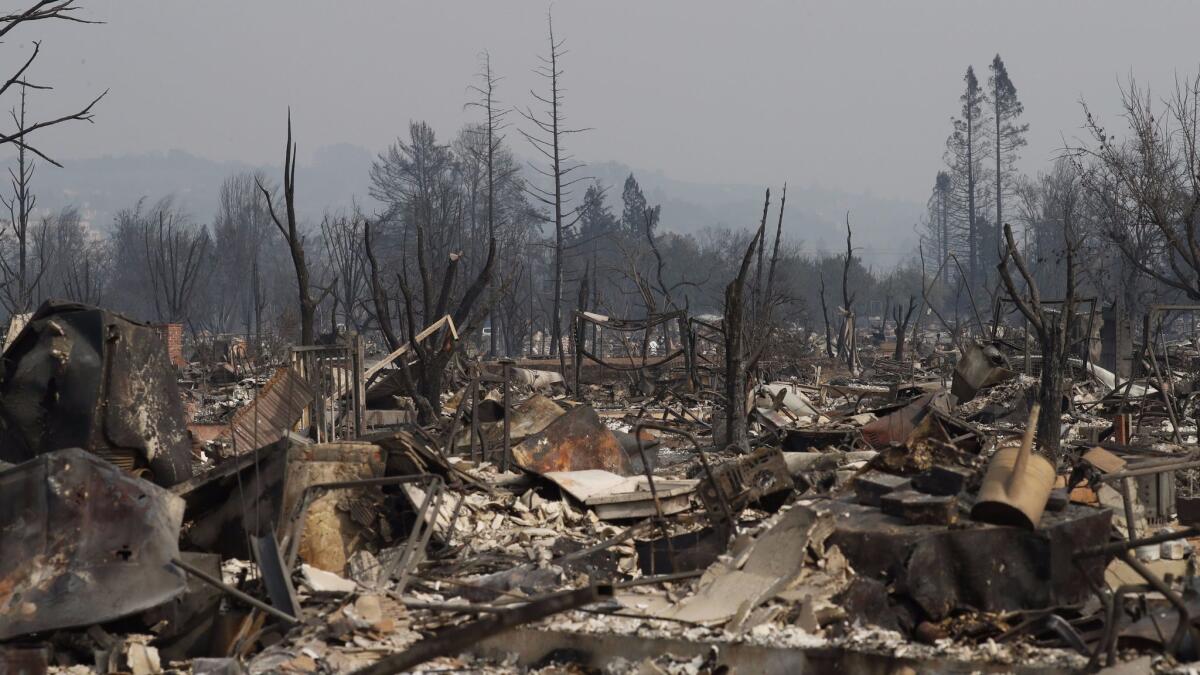Op-Ed: Santa Rosa’s charred now, but we’re all facing fire (or flood or heat wave) soon

- Share via
My wife awoke in the middle of the night to the smell of fire, investigated the house, and, finding nothing, tried to go back to sleep. On Monday morning, our deck was shrouded in black ashes, and the sky was a snarled gray, despite the absence of fog or clouds.
Forty-five miles to the north, in Santa Rosa, the locale of one of 17 fires that have turned parts of California into cauldrons, our nephew, his wife and baby daughter also awoke early Monday. By the time they decided they had to leave, at 6:30 a.m, homes a few miles away had been razed by flames. Their drive south to a relative’s house usually takes less than an hour, but this time it took two and a half hours because the road was clogged with evacuees. (Late Monday, they discovered their house was untouched.)
Most residents of Mill Valley, the town just north of San Francisco where we’ve lived for 34 years, have been no more than moderately inconvenienced by the fires, but they add to our unease. When we moved here, we thought of the town as a comfortable retreat. We didn’t consider its vulnerability to fire or, perish the thought, sea level rise. Now these threats worry us more than earthquakes. The reason for the change is simple: Like every other place on Earth, we are experiencing climate change.
The 1991 Tunnel fire, in the Oakland hills, delivered a warning to greenery-rich, hillside-hugging Bay Area towns like ours. That conflagration was so powerful that it generated its own wind and turned into a firestorm, leaving residents no time to flee— it killed 25 people, injured 150 and destroyed 3,500 structures. The ’91 fire was a sign that California terrain burns naturally, especially at the “urban-wildland interface” — in canyons and on slopes profusely covered in flora, where houses are built along narrow, twisting roads that hamper firetruck access and rapid evacuation. Nearly 30 years later, though, California’s October fire season has lengthened and escalated, as demonstrated by the flames consuming block after block of Santa Rosa.
Our only choice, wherever we are, is to fight tenaciously for sane climate change policies, or else we will get burnt.
The current fires weren’t a surprise. Two days before they started, a swath of North Bay counties began receiving “severe weather” alerts warning that the combination of unseasonably high temperatures, low humidity, “critically dry fuels,” and the “strongest offshore wind event so far this fall” had produced a high risk of a rapidly moving fire. Sure enough, one of the characteristics of these fires has been the “unprecedented” speed of their spread. “You’re talking 20,000 acres in essentially 12 hours, which is a phenomenal rate of growth,” said Jonathan Cox, a Cal Fire battalion chief in Santa Rosa.
All those factors — high temperatures, low humidity, strong winds — are exacerbated by climate change, and as climate change intensifies, they will, too. Though Mill Valley has not experienced a calamitous fire since the 1920s, the odds of its occurrence will steadily rise. And what all these fires have shown us is that in the face of a firestorm, we’re virtually defenseless.
Mill Valley has already been introduced to climate change in another way: sea level rise. Our home, at an altitude of 26 feet, isn’t likely to be inundated any time soon, but a section of one of the two roads into the town already is on occasion. When we moved here, that road, which curves around a San Francisco Bay inlet, never flooded; now it goes as much as a foot underwater several times a year, depending on tides and heaviness of rainfall. Sometimes cars slosh through the water, sending splashes high on both sides; other times the road is entirely blocked.
Add to these climate consequences predictions of increasing periods of drought in California, which will be punctuated by “atmospheric rivers” that produce damaging rain and wind storms, and Mill Valley no longer feels like a haven. There’s a tension in the air. Most mind-boggling of all is that our national leaders pretend that global warming doesn’t exist. They are busy erasing it from policy planning and even government reports, as if ignoring it will exempt them and their offspring from its destruction. It’s an astonishing gambit, offering a transient and perhaps chimerical political reward while insuring that future chroniclers — if there are any — will look on them as history’s biggest fools and villains.
We’ve considered moving, but where to? Climate change is a global phenomenon, already swallowing islands, glaciers and icecaps and generating bigger hurricanes, more heat waves, and floods of unprecedented intensity. Our only choice, wherever we are, is to fight tenaciously for sane climate change policies, or else we will get burnt.
Jacques Leslie is a contributing writer to Opinion.
Follow the Opinion section on Twitter @latimesopinion and Facebook
More to Read
A cure for the common opinion
Get thought-provoking perspectives with our weekly newsletter.
You may occasionally receive promotional content from the Los Angeles Times.









